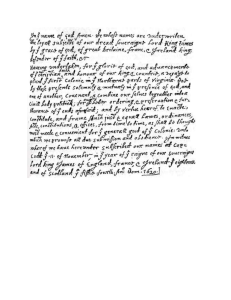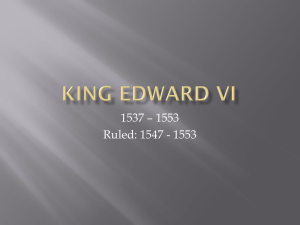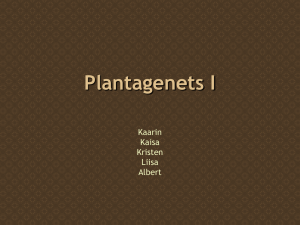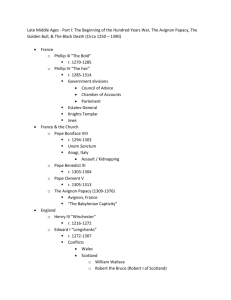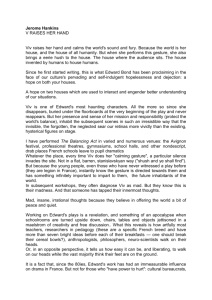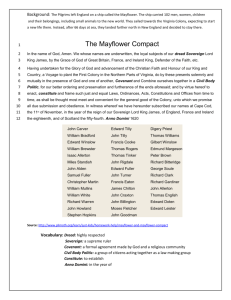Edward Stopforth
advertisement
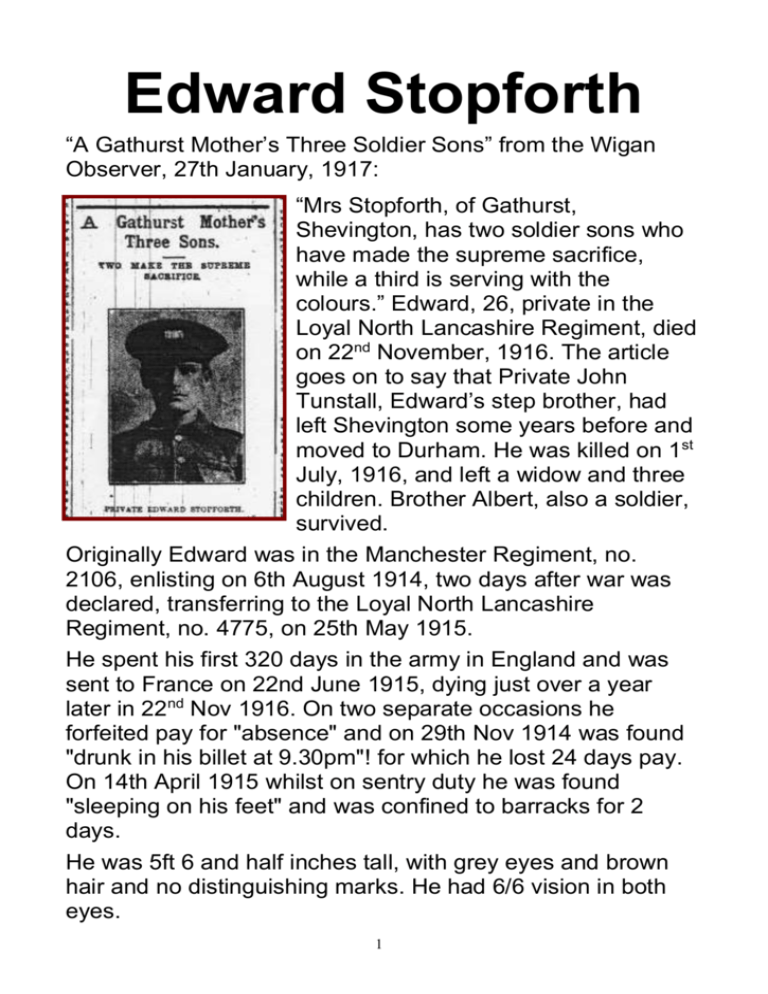
Edward Stopforth “A Gathurst Mother’s Three Soldier Sons” from the Wigan Observer, 27th January, 1917: “Mrs Stopforth, of Gathurst, Shevington, has two soldier sons who have made the supreme sacrifice, while a third is serving with the colours.” Edward, 26, private in the Loyal North Lancashire Regiment, died on 22nd November, 1916. The article goes on to say that Private John Tunstall, Edward’s step brother, had left Shevington some years before and moved to Durham. He was killed on 1st July, 1916, and left a widow and three children. Brother Albert, also a soldier, survived. Originally Edward was in the Manchester Regiment, no. 2106, enlisting on 6th August 1914, two days after war was declared, transferring to the Loyal North Lancashire Regiment, no. 4775, on 25th May 1915. He spent his first 320 days in the army in England and was sent to France on 22nd June 1915, dying just over a year later in 22nd Nov 1916. On two separate occasions he forfeited pay for "absence" and on 29th Nov 1914 was found "drunk in his billet at 9.30pm"! for which he lost 24 days pay. On 14th April 1915 whilst on sentry duty he was found "sleeping on his feet" and was confined to barracks for 2 days. He was 5ft 6 and half inches tall, with grey eyes and brown hair and no distinguishing marks. He had 6/6 vision in both eyes. 1 Edward’s family The 1911 census shows Edward, 22, as the oldest of five children living with Edward and Nancy Stopforth at 79, Gathurst Lane. The house is no longer there. Edward senior was a platelayer for the Lancashire and Yorkshire Railway, who operated the line to Southport. Our Edward, Edward junior, is described as a “Coal miner (below surface hewer at face)”. Two brothers, Hugh, 18, and Joseph, 13, are described as “hauliers” for Edward, probably meaning that they dragged the coal cut by Edward to the pit tubs. Edward may have been responsible for paying them. Also living in the house was a sister Agnes, 15, and a mysterious “grandson”, Edward Wilcox, 3. A complicated family Nancy was not Edward senior’s first wife nor he her first husband. Edward senior had originally been married to Ann, and they had had four children. Ann died in 1890 when our Edward was just one, and within a year Edward senior had brought Nancy Taylor to live with him as his “housekeeper”. Nancy brought three children with her who had two different surnames, Tunstall and Taylor. The two adults and seven children lived at “Douglas Meadows”, Gathurst Bridge. By 1901 the family had moved to “Oddfellows Houses”, also at Gathurst Bridge. Edward senior and Nancy had married and produced four more children, and the family of fourteen occupied two adjacent cottages. Edward junior is recorded as the head of the second house. Also living with them were John and Alice Tunstall, 58 and 57, probably Nancy’s brother and sister-in-law. Finally, in 1911 the (slightly) smaller family had moved to the (probably slightly) larger house at 79, Gathurst Lane. Along with Edward senior and Nancy were our Edward, his half siblings, Hugh, Agnes and Joseph, and “grandson” Edward Willcox, aged 3; he might have been the son of one of Nancy’s two daughters by her first husband. All the male children in the family worked in the mines. Edwina Taylor, Nancy’s daughter, made cartridges at Roburite, and her other daughter, Mary, was in domestic service. 2 Edward’s work Edward was a hewer in a coal mine. His job was to cut the coal from the coal seam, using a pick. This stone in St Anne’s churchyard records the deaths of our soldier, Edward Stopforth, in France, and also of his half brother, James Tunstall. Edward’s younger brother Hugh also died young and is buried in St Anne’s along with Edward Senior and Nancy, Edward’s step-mother. Although they had been married before, this second marriage for both of them lasted almost forty years. 3 What happened to Edward? Edward died on 22nd November 1916. His body was never found. His step brother, James Tunstall, also died in the war but his brother Albert survived It does not seem possible to identify exactly where Edward died. The 1st battalion of the Loyal North Lancashire regiment was involved in the various battles along the Somme River and Edward’s memorial at Thièpval suggests that he died in that area. The battle of the Somme apparently ended on 18th November. Perhaps Edward went missing in the last days of the battle and when it came to recording casualties a few days later, it was then that he was found to be missing. One source says when the regiment’s losses were totalled on 31st December 1916, 190 “other ranks” were recorded as missing. Perhaps one was Edward. This source mentions the Regiment fighting at Railway Wood and “Beek Trench” near Ypres. Here is a description of the trench:- “a mass of slime and rotten sandbags which it was our job to drain, duck board and rivet with corrugated iron . . . going up Beek Trench on a dark night was no picnic. You started along a long narrow alley winding uphill, your hands feeling the slimy sandbagged walls, your feet wary for broken duckboards . . .” 4

